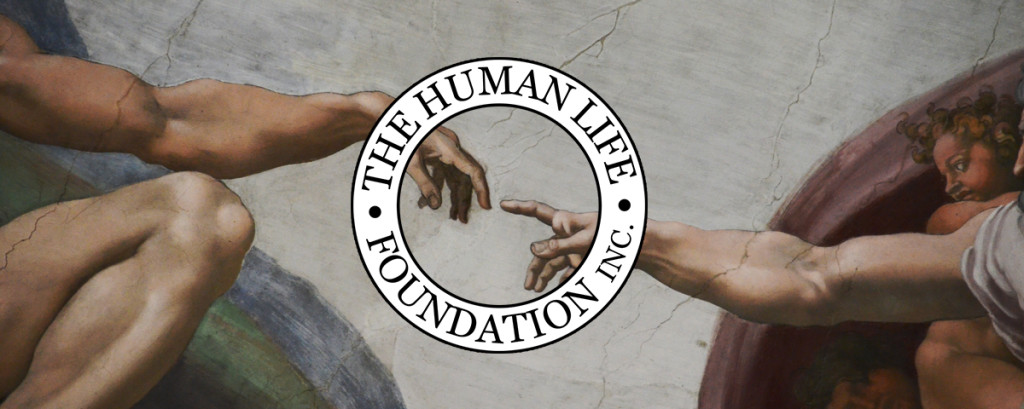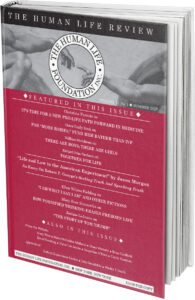INTRODUCTION: Spring 2025
As I write, news accounts of the pope’s early-morning death on April 21 still ricochet around the internet. This bit from the Wall Street Journal: “Pope Francis, who sought to refocus the Catholic Church on promoting social and economic justice rather than traditional moral teachings . . .” Well, yes, Francis did push for “social and economic justice,” taking a hard line on immigration and the environment. But some of his most startling rhetoric reinforced those “traditional moral teachings,” especially the Church’s hard-line position on abortion. “He made support for the weakest among us the rhetorical centerpiece of his papacy,” the Journal observed in a subsequent editorial. Yes, again, though the writer hardly had the aborted in mind. Our first article, and the column from our website by Margaret Hickey in Appendix B, pay tribute to this outspoken but rarely acknowledged defender of unborn life.
Written a few months before the pope’s death, Dawn Eden Goldstein’s “Pope Francis for Life: One Year in the Holy Father’s Defense of the Unborn” surveys pronouncements that may, she suggests, “surprise those who have chosen to tune him out” since early in his pontificate when he chided conservative Catholics for talking about abortion (and gay marriage and contraception) “all the time.” When Francis did talk about it, Goldstein writes, he “built upon the solid pro-life legacy” of his predecessors; to “abortion rights advocates [he was] a complete disappointment.” No wonder. There aren’t many pro-life leaders these days who publicly call abortion murder, as Francis often did: “Whether you like the word or not,” he told reporters during an inflight press conference last September, “it is murder . . . the Church forbids abortion because it kills.” In another notable departure from the soft discourse that prevails today, Francis routinely compared doctors who murder the unborn to “hitmen.”
Donald Trump rattled Hillary Clinton with the raw truth about abortion in their 2016 debate (see George McKenna, page 32). But today, as prolifers reckon with the second-term president whose first-term Supreme Court picks crashed the Roe regime, his rhetoric has softened: “I know your hearts are warm and your spirits are strong,” Trump told tens of thousands of March for Lifers in a video message two days after his inauguration last January, “because your mission is just very, very pure: to forge a society that welcomes and protects every child as a beautiful gift from the hand of our Creator.” It sounded, muses William Murchison in our next article (“The Time of Trump”) like “the kind of thing Ronald Reagan used to say.” Trump’s early pro-life initiatives, which our senior editor neatly recounts, have included (of course) restoring Reagan’s Mexico City Policy, only, as Murchison reports, he made it “even better,” having “ordered that the plan’s requirements be extended to global health assistance provided by all U.S. departments and agencies”—in other words, defunding the deep state’s abortion agenda.
Trump also used the March for Life video to announce his pardon of 23 prolifers unjustly consigned to long prison terms for peacefully engaging in civil disobedience.
We follow with two pieces featuring some of their stories: John Burger’s article “Rescuers Will Rescue” and Bernadette Patel’s interview with 70-year-old John Hinshaw, an “active prolifer” for going on five decades. “Rescues,” Hinshaw tells Patel, “are completely non-violent . . . When I sat down inside the late-term abortion mill of Cesar Santangelo, I knew I was trying to stop the murder of children . . . Little did I know that federal law enforcement was already conspiring against us.” His and other accounts of how pro-life miscreants were treated by jailors (and fellow inmates) are revealing. “Some had access to chaplains,” writes Burger, “others not.” Paulette Harlow, under house arrest due to health problems, “was permitted to go out for shopping and doctor’s visits, but not for church.”
“Many,” Burger continues, “said that they ‘offered up’ their confinement and whatever hardships they endured for the unborn.” Jean Marshall—who in her mid70s was “full body-slam pushed into the hall” during her arrest—told him “being in prison is part of the rescue.” Will Goodman “looked at the prison as a monastery as well as a mission field.” “Rescuing,” he reflects, is “a gift of self,” which begins “at the abortion center” and “continues through the arrest, through the trials, through prison.” Today, concludes Burger, the pardoned are still determined to block abortions, “even though the law that put them in prison is still on the books.” And, he predicts, if the Trump administration “refrains from enforcing it the way previous administrations did, we could be seeing much more rescue activity in the coming months and years.”
Meanwhile we are seeing more . . . murder. And even if “sometime soon the Supreme Court holds that the unborn are constitutional ‘persons,’” writes Gerard Bradley, “no one should think that ruling would end abortion.” Especially, he adds, “in our era of mail-order abortion-by-pill.” Bradley is one of 14 participants, mostly familiar but some new voices too, in “What’s God Got to Do with It?”—the symposium that covers over a third of this issue. (Unprecedented in our experience, all but one of those we invited to join accepted!) As you will see, our prompt (page 26) provoked a veritable feast of commentary: Do you agree, we asked potential respondents, “that for most people a conversion to belief in an objective morality that applies to everyone and therefore does not derive from political institutions or authorities but from a transcending authority—let’s say it, from God—is necessary for the pro-life cause to succeed nationally”? “Duh,” says W. Ross Blackburn. “The goal of the movement must be to save lives, not souls,” says Wesley Smith. “It’s complicated,” says Bradley.
“Mail order abortion-by-pill,” as Bradley and other symposium contributors noted, has been a game changer. Today, over half of abortions are chemically induced, and the number is bound to go up as more women in states with bans opt to abort in the bathroom instead of an out-of-state clinic. Mifepristone, the pill that makes it possible to dispose of a tiny human being in a toilet, has a long history. In “Playing Politics with the Abortion Pill: A Quarter Century of Abuse of Power at the FDA,”
J. Marc Wheat and Timothy Harper lay out in painstaking detail how a cancer drug came to be prescribed for abortion when “the statutory mechanism used by the FDA to approve mifepristone for abortifacient use clearly did not permit the drug’s approval.” Since its approval in 2000, they write, “despite consistent evidence” of dangers to women’s physical and mental health—and no matter what party was in the White House—“the FDA has repeatedly reduced the safety measures it had initially put in place” in order to “advance the pro-abortion political agenda.”
In “The Selling of Kate Cox: How the Media Failed to Report the Full Story,” Julia Duin examines the pro-abortion political agenda of the press as they railed against Texas’s restriction of abortion. “[D]ozens of reporters” wrote “fawning articles detailing (in their view) the near martyrdom” of Kate Cox, “the first woman in the country to sue for the right to an abortion” since Roe was overruled. It was, Duin says, “one of the savviest PR efforts in America’s 52-year-old debate over legalized abortion.” Cox’s unborn daughter, prenatally diagnosed with a condition highly likely to cause her death either before or shortly after birth, was (we were assured in mainstream stories) “endangering [Cox’s] health, her fertility, even her very life.” Duin wasn’t assured. Her subsequent investigation introduced her to women who, unlike Cox, had accepted their troubled pregnancies. “Why am I not reading about these people?” Duin asked herself as she discovered networks of women “who had decided not to abort” and the medical centers and perinatal hospices dedicated to helping them and their babies. Thanks to Duin you can read about them, in this article and in another she did for Religion Unplugged, which we reprint in Appendix A.
“Whether Catholic rulers can influence the State for the good of the Church as well as the common good,” writes Edward Short in our final article, “is a nice question”—one he first considers with America’s new vice president (“converted to the Church by America’s wonderful Dominicans”) in mind. In “JD Vance, Maria Theresa, and Catholic Rule,” Short looks at the “instructive life” of an 18th-century Catholic empress and mother of 16 children (among them Marie Antoinette) who ruled “her Hapsburg lands as she ruled her family, in a spirit of devout maternalism.” Instructive for the VP, as he considers such “lively” questions as “whether the loyalty on which Trump insists will result in Vance mitigating what ought to be his ethical opposition to his chief’s policy regarding IVF.” Instructive too for us: In a letter to her daughter Maria Carolina (who became Queen of Naples in 1768), Maria Theresa urged the young monarch to “lead by example, especially in this perverse age, when our holy religion is practiced and loved so little” and “the great are ashamed to profess their faith, while the people are mostly mired in superstition.”
Sound familiar?









